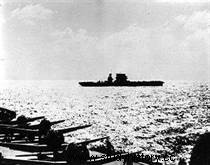 The Battle of the Coral Sea , which took place from 4 to 8 May 1942 between British-American and Japanese forces, was a major naval and air engagement of World War II. The Japanese, who already controlled much of the Pacific region from Peral Harbor, planned to conquer Australia and moved into position to prepare for this invasion. As a preliminary, the Japanese offensive was launched on May 4 in the Coral Sea. This battle by interposed aircraft carriers constituted a turning point in the course of the war because it hindered the advance of the Japanese towards the south.
The Battle of the Coral Sea , which took place from 4 to 8 May 1942 between British-American and Japanese forces, was a major naval and air engagement of World War II. The Japanese, who already controlled much of the Pacific region from Peral Harbor, planned to conquer Australia and moved into position to prepare for this invasion. As a preliminary, the Japanese offensive was launched on May 4 in the Coral Sea. This battle by interposed aircraft carriers constituted a turning point in the course of the war because it hindered the advance of the Japanese towards the south.
The context of the Battle of the Coral Sea
On December 7, 1941, the war officially began for the United States, which suffered a surprise attack on its harbor at Pearl Harbor. The blow is terrible and followed by many others until the end of 1941 and the beginning of 1942 which saw, among other things, the imminent fall of the Philippines, General MacArthur having abandoned Corregidor in March of that year. The allies of the United States suffered even more, in particular the British who saw their strongholds in Southeast Asia fall one by one.
But Pearl Harbor, dramatic though it was, saw the Japanese miss what was to become the main weapon of war in the Pacific:the aircraft carrier. Indeed, none of the American aircraft carriers were present at the time of the Japanese attack. At the beginning of 1942, the United States managed to reorganize and put in order a naval air force able to compete with the enormous Japanese power. The upcoming battle will be the first of its kind:at no time will the ships of the two sides be in visual contact, everything will depend on the air force... This is the prelude to the Battle of the Sea of Coral .
Australia under Japanese threat
The remarkable Japanese successes did not prevent tensions within the Japanese general staff, and the usual rivalries between the Army and the Navy , and even within it. Thus, Admiral Nagano wants an advance towards the West and India while Yamamoto advocates the definitive destruction of the American Navy (and in particular of its aircraft carriers) to obtain a favorable peace, believing that a long war was unwinnable. Yamamoto then wants to attack different points of support, such as Midway, before planning a landing in the Hawaiian Islands.
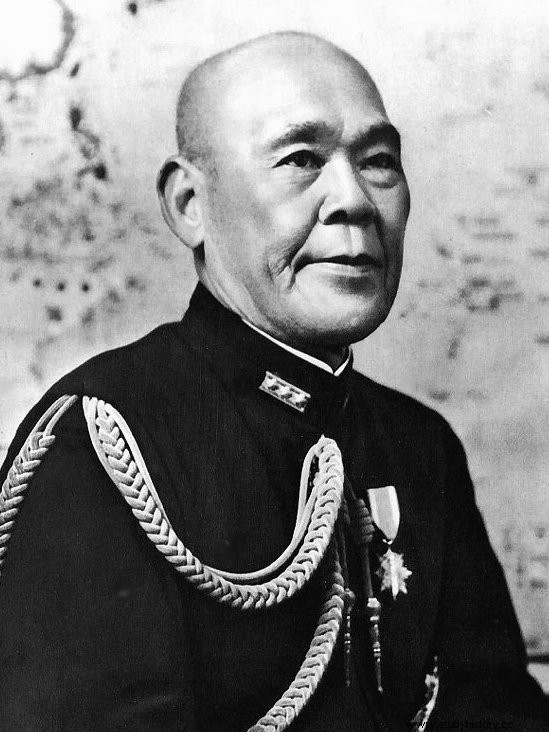 The army staff refusing to give the means to Nagano, this one decides to prepare a more modest project aimed at isolating Australia by taking Port Moresby in Papua. However, the Doolittle raid on Tokyo serves the theses of Yamamoto, who obtains the green light to launch an operation on Midway in June. But the preparations for an attack against Port Moresby being already advanced, it is maintained even if delayed from March to May because of the presence of American aircraft carriers in the sector. The operation is called “Mo”.
The army staff refusing to give the means to Nagano, this one decides to prepare a more modest project aimed at isolating Australia by taking Port Moresby in Papua. However, the Doolittle raid on Tokyo serves the theses of Yamamoto, who obtains the green light to launch an operation on Midway in June. But the preparations for an attack against Port Moresby being already advanced, it is maintained even if delayed from March to May because of the presence of American aircraft carriers in the sector. The operation is called “Mo”.
Americans in ambush
The Japanese organization for the whole operation is very complicated, shared between invasion groups (one against Port Moresby, the other against Tulagi in the Solomons) , a support group around the light carrier Shoho , and an assault force with large Zuikaku aircraft carriers and Shokaku . The Japanese know they are going to face a strong resistance but estimate the enemy naval presence relatively small, with only the probable presence of the aircraft carrier Saratoga .
However, the Japanese general staff ignores the essential:thanks to the decryption of their codes, the Americans got wind of the operation! Admiral Nimitz knows that Port Moresby is a crucial point, and that his downfall directly threatens Australia or at least Australia's participation in the rest of the war. From April 20, he understood that this would be the goal of the next Japanese offensive; but he does not have the Enterprise aircraft carriers at hand and Hornet , returning from the raid on Tokyo, while the Saratoga (contrary to what the Japanese believe) was hit by a torpedo and is under repair. He then summons the aircraft carriers Lexington ("sistership" of Saratoga ) and Yorktown , escorted by cruisers and destroyers (most of the battleships having been destroyed or damaged at Pearl Harbor). In total, Nimitz therefore has only 150 on-board devices, plus 200 in the region, particularly in Australia. On April 29, he appointed Fletcher commander of the operation and sent him to the Coral Sea for the 1 st may.
A “shy” first engagement
On May 3, the US forces are still divided and know nothing of enemy movements. They only learn at the end of the day that the Japanese have landed at Tulagi. Fletcher then decides to retaliate and heads full speed towards the Solomons with the Yorktown . The American commander has on his side Japanese people who do not expect an attack, as well as a zone of cold which masks his movements in a timely manner. On May 4, at 6:30 a.m., the Yorktown aircraft take to the air:12 Devastators (torpedo boats) and 28 Dauntless (dive bombers), while the fighters remain to protect the aircraft carrier.
The naval air attack being a relative novelty for young American pilots, it takes place in great confusion, the importance of certain buildings being for example overestimated…Result, to their Back to Yorktown at 09:31 they sank only three minesweepers and damaged one destroyer beyond repair. Two other attacks will cost the Japanese only two seaplanes and four landing craft… The Americans only lost three aircraft and Nimitz describes the operation on Tulagi as “disappointing”.
A game of hide-and-seek
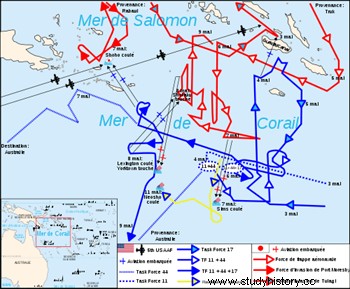 It is only two days later that the special force "Mo" enters the Coral Sea , led by Admiral Takagi, while Port Moresby was bombarded on May 5. The next day, Fletcher placed himself in battle order with an attack group made up of most of his cruisers, a lighter support group, and an air group with his aircraft carriers. Aerial reconnaissance followed, but the Americans failed to spot Takagi's squadron. This one, on the other hand, does not order any distant reconnaissance, in a rather inexplicable way.
It is only two days later that the special force "Mo" enters the Coral Sea , led by Admiral Takagi, while Port Moresby was bombarded on May 5. The next day, Fletcher placed himself in battle order with an attack group made up of most of his cruisers, a lighter support group, and an air group with his aircraft carriers. Aerial reconnaissance followed, but the Americans failed to spot Takagi's squadron. This one, on the other hand, does not order any distant reconnaissance, in a rather inexplicable way.
This more or less voluntary game of hide-and-seek delays the start of the confrontation, which is inevitable anyway. Only B-17s from Australia spot the Shoho and bombard it, but their size (they are heavy bombers) does not make them very effective against ships… Fortunately, they still spot the invasion force destined for Port Moresby. The Japanese are then optimistic:despite the enemy attack on Tulagi, the plan is going as planned.
Martyrs and Confusion
On May 7, Admiral Takagi finally orders further aerial reconnaissance. This comes at the right time, he thinks, as one of the planes sent spots two ships which he identifies as an aircraft carrier and a cruiser; a massive attack is then launched…but the targets are only the tanker Neosho and the destroyer Sims ! This one is destroyed, while the Neosho manages to drift in flames until May 11 when he is rescued by the destroyer Henley :the crew is saved, but the tanker must be scuttled.
The martyrdom of the two American ships however, is not in vain. Indeed, shortly before, at 06:45, Fletcher ordered his party of cruisers to engage the Japanese invasion force on Port Moresby. The American commander also plays luck when the enemy decides to concentrate his land-based air groups on cruisers rather than on his aircraft carriers. The confusion resumes however:the Japanese attacks fail, while American B-26s fail to sink their own cruisers!The Shoho , first victim among Japanese aircraft carriers
At 8:30 a.m., the Japanese reorganized:they spotted Fletcher's group , and the Shoho is about to attack him. At the same time, Fletcher also launched reconnaissance and "two aircraft carriers and four heavy cruisers" were spotted at 8:15 a.m.; the commander of the American squadron, thinking that this is Takagi's squadron, decides to send 93 planes between 9:26 and 10:30. But hardly the strike force in the air, the reconnaissance planes return and reconsider their assessment!
It would only be "two heavy cruisers and two destroyers"! It is too late to turn back, and the mission is confirmed in case the aircraft fall on the bulk of the enemy forces, necessarily in the sector. Fletcher Got it Right:Dauntless from Lexington spot the Shoho around 11 a.m. and engaged him, followed by their comrades from Yorktown . Hit by thirteen bombs and seven torpedoes, the Shoho dark at 11:35 a.m. On board American ships and bombers, it is euphoria, they have destroyed their first aircraft carrier of the war! 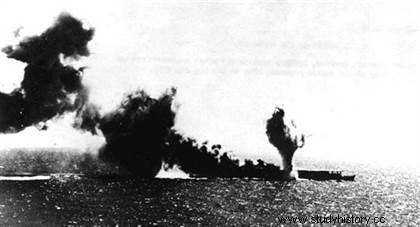
The Japanese are obviously furious, and they decide to counterattack by sending some of their best pilots (twenty-seven in total) for an attack late after -noon, due to depart from the aircraft carriers Zuikaku and Shokaku . But it's the American radar which, first of all, prevents the success of this response:it allows the interceptors of the aircraft carriers to repel a first attack, while the Japanese are hampered by bad weather. Then it's bad luck, almost comical:the Japanese pilots several times mistake the American aircraft carriers for their own and are miserably shot down as they try to land on their deck! Takagi thus loses two thirds of the experienced pilots he had sent on this mission...
The Last Round
On the morning of May 8, both sides know victory will go to whoever spots the other first. The problem is that they spot each other at about the same time, around 8:30 a.m. In addition, the air forces are equivalent on each side with 121 aircraft for the Americans and 122 for the Japanese! The only difference is in the weather conditions , slightly more favorable to the American camp.
The assault by Dauntless bombers and Devastator torpedo boats begins at 10:57 with the main target being the aircraft carrier Shokaku , the Zuikaku having managed to hide in a grain. Attack of the Yorktown Pilots seems relatively unsuccessful, the aircraft carrier being hit by only two bombs; but, the damage is significant enough that the Shokaku can only receive planes and not make them take off... On the other hand, the attack of the men of the Lexington ten minutes later is more decisive:the Shokaku too severely hit receives the order to fall back on Truk.
The agony of “Lady Lex”
The American squadron has therefore also been spotted, and it suffers Japanese lightning between its own waves on the enemy fleet. Japanese pilots, most of whom are already experienced and have participated in Pearl Harbor, are more skilled than their American counterparts. They base well organized on the two aircraft carriers at 11:18 am:the Yorktown more maneuverable manages to avoid eight torpedoes, and is only hit without great damage by a single 400 kg bomb. The Lexington is less lucky:he finds himself between two groups of enemy torpedo boats and collects four of their propeller bombs; he also takes two light bombs, one of which explodes in an ammunition bay… The battle is over. 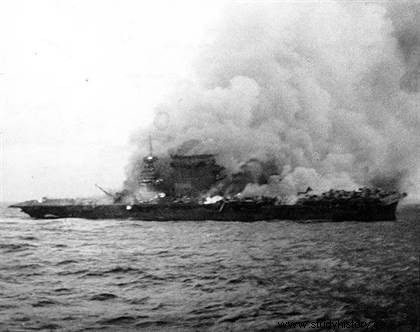
The Coral Sea, a decisive battle?
The Japanese, despite somewhat optimistic reports of the attack, decided to postpone the attack on Port Moresby. This infuriates Yamamoto, and he orders Takagi to resume hunting the American carriers; but Fletcher is already far away...The battle itself saw a victory in points for the Japanese:the losses of Lexington , from Neosho and Sims were far superior to that of the light aircraft carrier Shoho . But the Japanese fleet had also lost many of its best pilots and, above all, it was at the strategic level that the victory was American. This first battle in history between aircraft carriers had seen the failure of the Japanese offensive on Papua, and the damage suffered, in particular the need to repair the Shokaku and supply the Zuikaku , would weigh for the future. Indeed, another much bigger battle was about to take place off Midway …
Non-exhaustive bibliography
- F. GARCON, The Pacific War, Casterman, 1997.
- J. COSTELLO, The Pacific War, Pygmalion, 1982.
